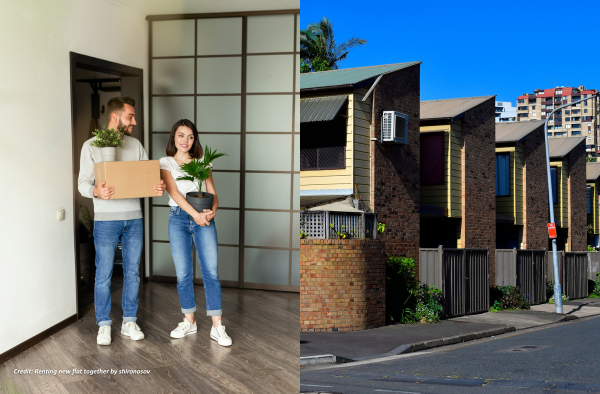Sydney is facing a major problem. The youth population in Australia’s largest metropolis is dwindling, transforming what was once a vibrant and dynamic place to live on par with global cities like New York and London.
One important aspect to consider is the increasing cost of housing, as upcoming generations are prioritising their ability to pay rent over owning a home.
“There’s a funny thing about Sydney,” NSW Premier Chris Minns told news.com.au in an exclusive sit-down interview.
“We’re about the 830th densest city in the world and yet by most measures, we’re in the top five or the top 10 when it comes to being the most expensive. Those two things are related.”
In February, the median unit price in Harbour City stood at $793,000, with the median house price at $1.34 million, according to the PropTrack Home Price Index. Over the past year, those significant figures rose by 8.23% and 6.16%, respectively.
According to SQM Research data, the median weekly house rent has surged by 12.2% year-over-year to $1049, while the median weekly unit rent has risen by 10.5% to $701 in the last year.
“I can imagine it’s really difficult, particularly for young couples,” Minns said.
“It used to be the case that people would say, when I was young, ‘Oh, will I ever be able to afford to buy a place in Sydney?’ And now a lot of people say, ‘Will I even be able to afford to rent a place?’ The cost of housing has exponentially grown.”
Youth migration patterns and trends
According to a recent report by the NSW Productivity Commission, there was a significant increase in the number of young people leaving Sydney over a five-year period.
From 2016 to 2021, in Sydney, around 35,000 people aged 30 to 40 moved away, while approximately 70,000 left, as per the information available.
According to Productivity Commissioner Peter Achterstraat, the city is at risk of becoming known as “the city with no grandchildren.”
“Sydney is losing its 30- to 40-year-olds,” Achterstraat said, adding authorities need to act now.
“Many young families are leaving Sydney because they can’t afford to buy a home, or they can only afford one in the outer suburbs with a long commute.”
In recent years, “many just up and leaving” has been attributed to the exorbitant cost of maintaining a roof over one’s head, according to Minns, who also warned that the mass exodus will be financially ruinous.
“If you’ve got so many young people up and leaving, then they’re not joining communities, starting businesses, going to the pub with their mates, and when they get a little bit older, becoming the coach of the football team.”
The city is not only at risk of losing its grandchildren, but also its once-vibrant nature, according to Minns.
“The measure of a city’s vibrancy is how many young people are part of it. If you can get young people part of a city, then they will open clubs, start businesses, and think about creative and fun ways of re-imagining the city.”
In December, the premier revealed his plan to address the issue and rescue Sydney, emphasising that “the city’s future is at stake unless we implement these changes.”
It has faced criticism in specific parts of the community, particularly among various Labour-controlled councils in important regions.
Proposed course correction strategy
The state government has introduced a three-pronged strategy, with the initial component centred around a transport-oriented development (TOD) programme. Eight transport hubs have been pinpointed as Tier One locations, where fast-tracked rezoning might result in the development of up to 47,800 new homes over the next 15 years.
Changes to planning regulations will allow for higher density in developments near metro or train stations in multiple areas such as Bankstown, Bays West, Bella Vista, Crows Nest, Homebush, Hornsby, Kellyville, and Macquarie Park by the end of the year. An important requirement for authorised projects is that 15% of residences must be affordable for key workers like nurses, teachers, and hospitality professionals, with construction starting within two years.
Minns highlighted the broader benefits that will arise from the greater supply for many renters and potential first-time homebuyers. Additionally, 31 other locations across the state are set to be rezoned to allow for increased densities within 400m of metro or suburban rail stops and town centres.
Developing new residential properties in regions with existing infrastructure is a strategic move. Several potential locations under consideration are Ashfield, Dulwich Hill, North Strathfield, North Wollongong, and Gosford. In specific suburbs, the government’s proposal involves permitting a range of housing options, including flats, terraces, and duplexes.
Each council enforces specific rules on the types of residences permitted in their areas, often restricting certain building structures.
“If a council doesn’t change its rules, then the State Government’s rules will … apply, to confront the housing crisis,” a Department of Planning and Public Spaces briefing note reads.
Having a guidebook with pre-approved designs for those housing types will help speed up development. In Tier One locations, there has been a total of $520 million committed to community infrastructure projects to accommodate the increased density. These projects involve public open spaces and road upgrades. Minns described the significant changes as “modest,” taking into account the potential outcomes.
“We can have a modest change to the amount of people or houses that we build each year, and over time it can make a massive difference to the cost of housing,” he said.
Two Labour councils have voiced their opposition to the plan, stating that it may lower living standards for residents by oversimplifying the current rules.
Inner West Council and Canterbury Bankstown Council criticised the premier, stating that the reforms will significantly impact their residents and suggesting the possibility of a legal challenge.
According to Fairfield Mayor Frank Carbone, Minns is expected to transform western Sydney into Kolkata, a city in India with a population of 14.8 million, and signal the disappearance of the backyard.
“This is not an attempt to demolish Sydney and start again,” Minns said. “These are pretty modest in the scheme of things.
“A little bit more will go a long, long way. Not doing anything is not a solution. Cities that don’t do that lose their vibrancy, their character. Ironically enough, you do change the city by not changing it all.”
Minns emphasised that he was not elected to prioritise popularity or make decisions based on political gain.
He’s hopeful he can “get people on the fence to say, ‘You know what, something needs to change, it’s not going to destroy the city, I can sign up to that.’”
And he issued a call to arms to young people across the state, declaring that “we’re in this for them”.
“We want them to claim their bit of this great city because that was what was given to their parents and their parents’ parents and the generation prior to that.
“We don’t want young people in NSW to be the first generation to miss out on their bit of Sydney.”
Addressing Sydney’s housing shortage
The consequences of inaction were clearly highlighted in the Productivity Commission’s report.
An estimated 45,000 additional homes could have been constructed between 2017 and 2022 without the need for extra land by permitting taller buildings in strategic locations, according to Achterstraat.
“This could have seen prices and rents 5.5 per cent lower – $35 a week for the median apartment, or a saving of $1800 a year for renters.”
In 2023, New South Wales constructed 48,000 new residences throughout the state, resulting in approximately six houses for every 1000 individuals.
That number is significantly lower than the 59,000 completions in Victoria, which translates to eight homes per 1000 residents, with the state even falling behind Queensland.
He supported the idea of developing Sydney’s inner suburbs instead of just focusing on the outskirts. This approach could lead to increased productivity and wages, reduced carbon emissions, and the preservation of land and green spaces.
“Sydney needs hundreds of thousands of new homes over the next two decades. Building more in the places people want to live is a key piece to solving the housing jigsaw puzzle.”
He also emphasised that density can be achieved without compromising the historical charm of suburbs like Balmain.
“We can preserve the gems of Sydney’s heritage without inadvertently freezing young people out.”
Public Spectrum is the first knowledge-sharing platform in Australia to embrace the entire public sector. This website is a platform where you can connect, collaborate, empower, inspire, and upskill with public sector professionals.






























































